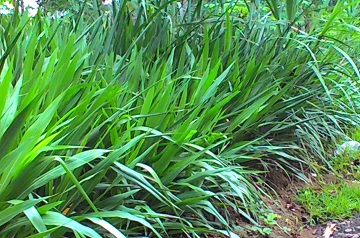A Group of Researchers of IPB Developed Drought-resistant Grasses as Forage for Ruminant Animals

Ruminant production sub-systems cannot be separated from the overall issues involved in upland development as these are important for crop production and farm households' economy. Many of the smallholder households keep ruminants (cattle, sheep and goats). Ruminant farms in Indonesia are dominated by smallholding livestock farms. Most farmers use grass as the main feed for livestock feed. However, the constraint faced by farmers is the availability of forage. Quantity, quality, and forage continuity are inhibiting factors of forage feed.
Concerned about the sustainability of the beef industry, a group of experts of Bogor Agricultural University (IPB) implemented research program on techniques for screening grass plant resistance to drought and stresses and its potential development in dry areas with Leisa techniques. This research was carried out by Moh Ali Hamdan, Panca DMH Karti and Iwan Prihantoro from the Department of Nutrition Science and Feed Technology of the Faculty of Animal Husbandry (FAPET).
Panca said, Indonesia has a high diversity of grass species. Grasslands such as savannah and prairie where grasses are dominant are estimated to constitute 40.5% of the land area of the Indonesia. However, as a tropical country, several regions in Indonesia have different seasons as the rainy season is shorter than the dry season. A major problem facing livestock producers in Indonesia, a tropical country, how to provide a proper nutrition for their animals, especially during the dry season when pasture and cereal residues are limiting in quantity and nutritional quality.. However, in several dry climate area, forage production is still low when it is dry season. So, the study about forage is very urgently and importantly needed. For regions that have longer dry season than rainy season, the availability of forage becomes an obstacle factor for livestock development. "Animal industry especially stockers needs forage as their fibre and protein resource to maintain its quality and productivity," he said.
He said, the high diversity of grass species in Indonesia became a potential for livestock. The shortage of feed, particularly during the dry season is one of the major factor limiting productivity of livestock in Indonesia. There are some grasses that are resistant to drought, so availability can be a mainstay for livestock needs. Napier or elephant grass (Pennisetum purpureum Schum.) shows a great potential to alleviate the problem because it is drought resistant and has high dry matter yield potential. This is certainly a potential to be developed so that its availability is not too affected by the season.
He also added that efforts to develop drought resistant grass can use LEISA techniques. Low External Input Sustainable Agriculture (LEISA) is receiving increased attention, both as a sustainable alternative to Green Revolution-like strategies making intensive use of external inputs, and as a strategy of sustainable agriculture in resource-poor environments where no or very few external inputs are used. In areas with a high production potential, LEISA can simultaneously improve ecological sustainability and farmers' socioeconomic conditions by reduced use of external inputs. In areas with a low production potential, LEISA can stabilize and restore the carrying capacity, but generally has limited potential to improve socioeconomic conditions for growing populations, and an increased production may also result from a further depletion of natural resources, and by a limited number of farmers. The term low-input agriculture has been defined as a production activity that uses synthetic fertilizers or pesticides below rates commonly recommended by the Extension Service.
Based on the results of the research, drought-resistant grasses and suitable for the field are coronan grass (Brachiaria humidicola Schwieck). It has good drought tolerance and remains green better than other species with better dry-season production. This research conclude that Pennisetum purpureum Schum. cv. Mott has capability to be planted on dry land areas as forage-based feed sustainability. This grass, is by far the most cultivated grass and in Indonesia it is mainly used in cut and carry system for dairy and beef cattle feeding. The high dry matter potential, ease of propagation, cultivate and harvest are the reason for its popularity among the farmers. (Wied)



